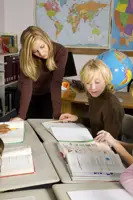 This year’s presidential election reminds us that history is being made every day — so how will kids ever learn about it all? It is probably not possible for them to learn everything, but the State and energetic teachers are doing their best. And parents can help too.
This year’s presidential election reminds us that history is being made every day — so how will kids ever learn about it all? It is probably not possible for them to learn everything, but the State and energetic teachers are doing their best. And parents can help too.
The beginnings of history lie in social studies, which usually starts in kindergarten. In social studies, children begin learning about themselves in the context of their relationships with others.As they progress through elementary school, the scope of the curriculum broadens to include communities, local history, and then United States and North American history. Karen Alevy, coordinator of social studies and English language arts for the Clarkstown Central School District in Rockland County, explains that the New York State Social Studies Standards and Core Curriculum determines the dimensions, concepts, content and skills to achieve for each grade from kindergarten through high school.
How History is Taught
No Child Left Behind’s emphasis on preparing children for reading, math and science tests has left less time for social studies in many schools, according to veteran first grade teacher, Paula Rogovin.But at The Manhattan New School, P.S. 290, where Rogovin teaches, students scored high on the standardized tests, so she can devote more time to social studies. Her approach is with a “community” theme – Rogovin’s class studies buildings, restaurants, and sanitation vehicles. Rogovin encourages her students to ask questions, and find answers through books, trips, role playing, video, mural painting, recipes, and interviews. She regularly takes them to a construction site where they watch a condo being built, and meet the workers, interview them, and write about them. In researching the lights for the building, for instance, they learned about Lewis Latimer, who developed the filament for incandescent light bulbs, and invited Latimer’s granddaughter to visit their class. Rogovin says, “We learn history by backing into it.”
By fifth grade, “when students must take a state-mandated social studies test, there is definitely some teaching to the test,” says Leslie Profeta, a fifth grade teacher at the Manhattan New School. Her goal is to get kids to understand the answers to certain essential questions. “When I teach the Constitution,” she explains, “the essential questions are: what is its purpose, what is the balance of power?”To explore these questions, her students stage a mock First Amendment case in a Brooklyn courthouse and actually argue the case.
Kaycee Von Essen, a third grade teacher at Sleepy Hollow’s W.L. Morse Elementary School in Westchester County, explained that social studies there is integrated into the English Language Arts (ELA) program. Her students study the geography of the United States, China and Brazil. Von Essen says, “My students learn history through exploring how geography affects people’s lives, how it determines what products they produce, and how it influences their government.” They use a variety of articles, videos, and trade books that are also used for ELA comprehension skills.
Because social studies sometimes gets short shrift, Jeff Neary, a fifth grade teacher at Roberts Avenue Elementary School in Danbury, Connecticut, works with an ELA specialist so that social studies materials can be used to meet reading objectives. With a curriculum that spans from the Native Americans to the Revolutionary War, he admits that gathering materials that can also be used for ELA is challenging.
Changes in Social Studies Teaching
 Technology has altered the way students learn history. “Today, kids can access websites, take interactive field trips, see pictures so that they know what things actually looked like in the past, and explore much more material at different levels,” Neary notes.
Technology has altered the way students learn history. “Today, kids can access websites, take interactive field trips, see pictures so that they know what things actually looked like in the past, and explore much more material at different levels,” Neary notes.
And it has altered the way teachers teach the subject. “Technology has changed the way we access, organize, analyze and evaluate information,” says Alevy. “It allows teachers to collaborate with experts and one another more easily.”
Both Alevy and Neary note that the teaching of history now places more emphasis on major themes and concepts — in contrast to the rote memorization most of us remember.
Dealing with the volume
Because history is ever expanding, it’s inevitable that some events are left out of the curriculum. The New York State Social Studies Learning Standards and Core Curriculum recognizes that “… some events are more important than others, that some have had more influence than others…” The Connecticut State Department of Education develops social studies standards for grades K-12 which reflect national standards, however each school district is free to develop its own social studies curriculum using the state standards as guidelines.
The 2008 draft, Social Studies Framework, urges individual school districts to decide what gets left out and included by emphasizing “content that can serve as building blocks for content to follow.”
“I try to touch on everything so the kids at least have an understanding of the timeline and general concepts,” says Neary, “and then I go into more depth if I have time.”
Social Studies Beyond the Classroom
You can continue exposing your children to social studies outside of school. The teachers interviewed urged parents to read the newspaper and watch the news with their kids. They encouraged families to visit museums and historical spots whenever possible.
They also recommended these resources:
• www.puzzlemaker.com: Create your own word puzzles
• www.funbrain.com/funbrain/where: A map game
• www.gamequarium.org/dir/Gamequarium: A compendium of games on various subjects
• National Geographic for Kids:http://kids.nationalgeographic.com – Kids’ games, animal photos, stories and more
• http://earth.google.com: Google Earth – Fly anywhere on earth
• www.timeforkids.com: Time for Kids
• American Memory: http://memory.loc.gov/ammem/index.html – Photos, documents, and recordings from the Library of Congress
• Zoom Explorers: www.enchantedlearning.com/explorers/indexa.shtml – A comprehensive directory of explorers and their routes
• www.enchantedlearning.com/history/us/symbols: Symbols of America explained and illustrated
• www.ushistory.com/stories1.htm: History stories on music videos
• Plimoth Plantation: www.plimoth.org
• National Archives: www.archives.gov
• Smithsonian Institution: www.archives.gov





















